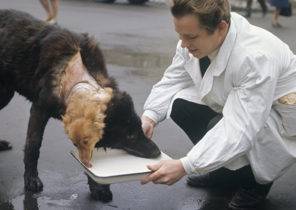
As soon as the growing tensions between the United States and the Soviet Union after the Second world war, Denmark caught between the ambitions of two great powers during the cold war.
Over the five-year German occupation, and Denmark began, with the aim of strengthening the position of countries in the world and scientific sovereignty over Greenland during the cold war was of great strategic importance to the two superpowers — USA and Soviet Union.
The whole history of top-secret diplomatic battles, military operations, research and media above described in the new book “exploring Greenland: science of the cold war and the technology on ice” (Exploring Greenland: Cold War Science and Technology on Ice).
“The history is full of intrigue,” says Christine Harper (Kristine Harper), lecturer in the history of science of Florida State University who also is a meteorologist and oceanographer.
Kristine Harper was a senior researcher of the project Exploring Greenland, which ended in 2013, and one of the editors of this new book published in 2016.
Secret documents reveal the political struggle for power
The book reveals the efforts of the government and military of the United States to obtain territorial control over Greenland, and shows the political situation, like the fight of David with Goliath, which involved Denmark, Greenland and the United States.
“We already know that the United States during the cold war, was very interested in Greenland. But we don’t know the whole scope of their research programs,” says Ron dowel colon (Ron Doel), lecturer on the history of Florida State University and one of the senior researchers of the project Exploring Greenland.
The now published secret documents reveal hitherto unknown details about the US interest in Greenland, and show that Denmark has influenced the activities of the U.S. is stronger than previously thought, explains Ron dowel colon.
Scientists have carefully studied national and private archives on both sides of the Atlantic, to provide new data about the actions of Denmark and the United States.
Greenland had a strategic importance for the United States
For the first time the us government has shown interest in Greenland during the Second world war, when Denmark was occupied by Germany.
The strategic position of Greenland in the middle between the United States and war-torn Europe and the fact that she does not fall into the hands of the enemy, had great significance for the allies.
Greenland was an important point of intermediate landing of allied aircraft when flying across the Atlantic, and the weather station located everywhere in Greenland, gave the information to compile accurate European weather reports, which had crucial importance for the successful operations of the allied forces.
“The allies were forced to invade Greenland because there was no way to prevent it is Germany,” says Christine Harper.
1941: US foothold in Greenland
On the same day when German troops crossed the border into Denmark, the United States agreed on the supply of goods and placement of military units in Greenland.
When the United States entered the war in 1941, the Danish envoy in Washington, Henrik von Kauffmann (Henrik von Kauffmann) allowed the Americans to build military bases in exchange for recognition of Danish sovereignty.
The Americans immediately set to work. They are equipped with a runway, built a military base and research station. They produced about 7 thousand of meteorologists and sent part of them to the weather station in the Arctic region.
In 1944 American troops in Greenland consisted of 5 795 military and civilians, accounting for nearly 25% of the local population (21 412).
By the end of the war, the weather service of the us army has built 14 stations, which simultaneously served 13 Danish stations built before the war.
The Americans also seized a number of secret German weather stations located in very remote East coast of Greenland.
Greenland — the largest aircraft carrier in the world
Even after the war, Greenland was still strategically crucial for the United States. She was in the middle between the US and the growing Soviet threat.
Many in the U.S. government took over Greenland and the Arctic region as the next hot spot and a warmer and ice-free Arctic ocean as a possible way for the Soviet invasion of the United States.
“Greenland played an absolutely crucial role in the defense of North America,” says Ron dowel colon and adds:
“The article in Time Magazine from January 1947 Pentagon official describes Greenland as the largest aircraft carrier in the world. This well describes the attitude of Americans. They believed Greenland its military base”.
Now, however, have permission to conduct operations in Greenland was not enough. On the horizon loomed the cold war, and the us government wanted to become the owner of Greenland.
Denmark: Greenland is not for sale!
“The Danish foreign Minister John Christmas møller (John Christmas Møller) visited the United States in 1946, and the U.S. government immediately offered to buy Greenland,” says Matthias Heymann (Matthias Heymann), the chief researcher on the project Exporing Greenland, lecturer at the Department of mathematics at Aarhus University and one of the editors of a new book.
“The Danish foreign Minister was absolutely not ready to such turn of events. He arrived in the United States, to inform their American counterparts that American military units should leave Greenland”.
“The Danish government was totally ignorant of the plans of the Americans in Greenland. It did not know about the huge interest the American army to this territory”.
The American government offered to buy Greenland for $ 100 million, a very attractive offer, taking into account the economic situation of Denmark after the war. The response of the Danish government was resolute refusal.
“Denmark is a small country, which until recently during the Second world war was occupied by Germany, a strong military power. Denmark had no desire to relive it,” says Matthias Heymann.
At that time the relationship between Denmark and the Soviet Union were very tense — the Soviet Union just went from Bornholm, on 5 April 1946.
Rejecting the American proposal, Denmark has made it clear: Greenland is not for sale.
The weather station became the subject of controversy
Denmark has consolidated its sovereignty over Greenland, restoring control over the most important scientific institutions and research facilities.
Immediately began funding the preparation of geological maps, research of oil and mineral deposits, hydrographic works, research of ice, and in 1946 was established the geological survey of Greenland (GGU).
Soon the dispute became a weather station.
“Arctic weather stations, established during the cold war, was crucial to the sovereignty,” says Ron dowel colon.
“If you now build a weather station in Northern Canada that will serve the American scientists, will this mean that the United States has sovereignty over this part of Canada, because the Americans support these weather stations? This would cause concern to Canadians. For the same reason and the Danes wanted to control the weather station in Greenland,” explains the scientist.
Brutal realities: USA win
Danish Ministry of foreign Affairs has sought to establish control over the weather stations, but this was problematic:
“Denmark was not able to do it,” says Matthias Heymann and continues:
“It was promised to send personnel, and even a contract was signed that determined what personnel was needed there. But subsequent years showed that these promises could not be fulfilled.”
“The scientific institutions in Denmark, for example, the Danish Meteorological Institute, was more realistic. They said: “It is simply impossible to do. We do not have sufficient personnel. That’s impossible.“ But the Ministry of foreign Affairs said: “We must comply if we want to defend our sovereignty. You have to make sure that they worked.“ Such was the situation in the period from 1940 to 1950,” explains Matthias Heymann.
Since Denmark was not able to obtain a sufficient number of educated meteorologists, the United States continued to serve the majority of weather stations.
“It’s just a small piece of history, but it is interesting, because it shows a great desire from the Danish Ministry of foreign Affairs to establish full control,” says Matthias Heymann.
Humility before rich Americans were a topic which was constantly raised in subsequent years.
The sovereignty installed but conflicts
In 1951, Denmark and the USA signed a Treaty which allowed the us military to settle in Greenland and established new rules of the American scientific work in Greenland.
Denmark gained full sovereignty over the island, and the American military got permission to keep military bases in a very specific area.
All scientific activities and all military action outside the marked area had to obtain the consent of Denmark.
“Now, the Danish authorities calmed down, because the question of sovereignty was resolved once and for all. But during the fifties of the last century appeared again concerns. The Danish government constantly amazed at the scope of U.S. action,” says Matthias Heymann. He continues: “the Thule Base was to play an important role in North-West Greenland. It was the largest airbase outside the US, that indicates its value. Tula was also the center of various scientific works.”
Camp century US: “the city under the ice”
The construction of the base began in Tula in 1951. In 1954 the United States created science camp, camp Tuto (Thule take off — approx. ed.), which was built 25 kilometers South-East from the base right at the edge of the inland ice, where there was a good possibility of direct access to the ice.
In 1958, the Americans began work at camp century. This Arctic base has been built more than 200 kilometers to the East from the base of Tula, at a depth of 8 meters under the surface of the land ice on the area of 55 hectares.
In a propaganda film of the U.S. army 1963 base camp century described as the “city under the ice” with all modern amenities, clinic, Church and so on. Heat and electricity came from mobile nuclear power plant.
Working at camp century began outside a us military site and without the permission of Denmark.
The challenge to the sovereignty of the cocktail party
Informal letter of 1959 was the first request of the us government to allow placement of camp century. Out of fear of Soviet reaction Denmark rejected an American request.
“But in August 1959, the American Ambassador informed the Danish foreign Minister that the Americans have already started to build camp century on the mainland ice. This happened quite informal cocktail party,” says Matthias Heymann.
Shocked, the Minister immediately called an emergency meeting to discuss the response of the Danish government. But, in the end, they had little to do.
“They were hard, but they had to admit that the US de facto had established their military sovereignty. Denmark could not stop the American troops,” says Matthias Heymann.
Danish censorship of the media fails
The result is a permission to continue the project, and the Danish Minister of foreign Affairs, insisted on censorship in the media.
But it was too late. The Danish authorities did not know that for a couple of days before the American magazine The Sunday Star published about camp century is a great article. The story came out.
The Danish government now could only convince Folketing and the Danish people that it was a civilian project, and to control and limit media access to the camp.
The Danish Embassy in Washington began to censor the messages of journalists on the activities of the Americans in Greenland, removing all politically sensitive topics and rewriting messages to it they were just about civil trials.
The journalists were given permission to visit the camp to a very limited extent. In addition, Denmark has banned contact between the Americans and the local Inuit population.
American troops was a problem for Denmark
The official version offered by Danish and American public, was that camp century is the civil framework, built in order, according to documents compiled in connection with the project, to study the weather and make measurements of snow during the whole year in a strategically very important region.
But camp century — it was something much more. It was studied important for the American geophysical disciplines: seismology, meteorology, climatology, glaciology, Geomagnetism and properties of ice and snow.
But the true purpose of the military was to use a database and the information collected for the project “Ice worm”, which included 600 nuclear bombs to missiles and medium-range missiles, which were to be installed in the tunnel system with a total length of more than 4 thousand kilometers at a depth of 10 meters below the surface of land ice.
Every year there were performed drilling works for the construction of new tunnels to fire rockets all the time position. The whole complex was to occupy 140 thousand square kilometers, and for the maintenance of this system it was necessary to have 11 thousand people.
The Danish government did not know about the project “Ice worm.” Only the Danish Prime Minister knew about the likelihood of work in Greenland with nuclear weapons.
The public first heard about this project when, at the initiative of Folketing Danish foreign policy Institute (DUPI) in 1997 issued a major report on flights over Greenland the American aircraft with nuclear bombs on Board and on the role played by this base Thule.
Greenland became less important strategically
By the end of the sixties of the last century military interest of the United States to Greenland began to fade. New technology meant that Greenland could hardly play a crucial strategic role.
Successful testing of strategic ballistic missiles long-range, submarine-launched and equipped with nuclear warheads, as well as the progress in the development of the aircraft meant that the Americans no longer depended on Greenland.
Camp century was closed in 1967. Engineers found that the ice had changed more than they expected, and in 1962 they began to notice the narrowing tunnel passes due to the unexpectedly large movement of snow and ice on the surface.
Air force base of Thule, which for some time was the largest base in the us territory, much reduced in size. In 1968, her team consisted of 1 189 people.
Even the question of who should support weather stations and maintain them became less sensitive, the workstation in bόlsei extent was equipped with automatic systems.
USA to Greenland is still a controversial topic
But the US is not entirely gone from Greenland and the topic today is politically sensitive.
“Greenland remains a zone of safety, it remains a place where U.S. troops are engaged in listening and observing. In Greenland there are giant installations, and Americans have no desire to abandon them in the near future,” emphasizes Christine Harper.
Recently a new study has shown that climate change associated with another politically sensitive topic.
Remaining under the snow equipment camp century may be in the zone of melting, and not in the Arctic ice, which should securely hold the waste from contact with the Arctic environment.
So now the question arises, who is responsible for waste management: Denmark, USA or Greenland?
Greenlanders remained on the sidelines
Today, technologies developed by military research activities, worldwide, are the basis for climate researchers, is extracted from boreholes in the Greenland and Antarctica ice.
Danish, American and Swiss scientists have created the first draft of the drilling samples, the aim of which is investigation of a core of ice.
Today in Greenland every year from around the world come scientists to study the changes of ice and ocean.
Computers gave scientists the opportunity to develop working models of circulation in oceans and atmosphere, to study the centuries of climate change, the human impact on climate and fragile Arctic ecosystems.
But the struggle for scientific sovereignty is not over.
“This is a strange story because we are talking about Greenland, which is in the hands of the United States and Denmark. Residents of Greenland do not have voting rights,” says Matthias Heymann.
Currently, Greenland has its own scientific agenda
The Foundation of the government of Greenland entered into force on 1 may 1979. The Board of Greenland enforces the interests of Greenland and because of their status make Greenland part of the Danish-Faroese-Greenlandic state of the Commonwealth.
Currently, Greenland is developing a private, self-governing, independent research agenda.
Institutions such Ilisimatusarfik, University of Greenland and Asiaq, the Greenland Research in permanent collaboration with Danish and international research institutions create the future scientific activities in Greenland.
This article was first published in ScienceNordic. Translation Of Stefanie The Lammers-Clark (Stephanie Lammers-Clark)






